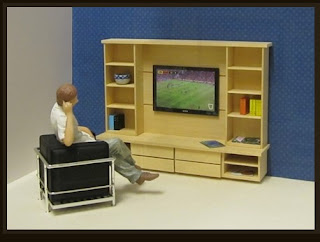I am about to show you the very best piece of kit used to wire your house for all its lights and fires.
 |
| small tidy solution |
This handles 85 bulbs and only measures 5.5 inches long by 1 inch wide - probably smaller than the usual ugly white plug socket, gang plank affair you normally find on houses. You can get even smaller versions so it would be easy to conceal them in different parts of the house in furniture, outhouses, chimneys etc and you could then have totally hidden wiring. they also come switched.
I am all for simplicity with a house which always has its back to the wall and all my electrics will just run to this block.
This came from a (new to me) vendor called Little Houses Plus and I am so relieved to have found them.
The product is made by Small World Products and I first used it when the lovely man who owned the company sent me one to trial after reading something I wrote about my frustration removing and, worse still, replacing those wretched little plugs you get on lights and fires. From then on, for me, it was a no-brainer - this is the very best way to light your house.
Sadly I seem unable to order from their site any more although I am convinced I saw them at the York Show? Happily during all my frustrated trawling for ways of emailing them without a bounce I discovered Little Houses Plus who seem to stock the product and here it is.
For the un-electrical bodies reading this do not be put off by its electricalness. I totally understand the initial reaction of - I can't do that, I just want a simple plug and socket. I did exactly the same. I assure you fiddling around with those blessed plugs and relying on the unreliable commonly found cheaply made white socket gizmo is far more trouble than finding your way round this. That said, if you are only doing up to half a dozen lights - fair enough go for the cheapest most available option. I will have something like 40 bulbs (maybe more). Please note, the number of bulbs is the important factor, not the number of lights. A chandelier can have six or more bulbs, for example.
 |
| power connector |
I would think everyone has seen a connection like this (centre pin socket) on things like transformers for radios, games etc. This is where your transformer connects by simply pushing it in the socket. For anyone new to the game the transformer is that big block that you have which has a plug on one end and a connector to fit this on the other. It connects your real house power to your little house wiring and, in effect, reduces the power to mini size.
 |
| fuse |
This might be a bit confusing but it is explained with the instructions you get. It does say 5A (five amps) next to the fuse so you might think that's what it is..... not so.... it comes fitted with a two amp fuse. Each amp controls about 14 bulbs so you can work out what fuse you need and what size transformer is needed. This 2A fuse therefore will control about 28 bulbs. If, like me you want more it is a simple job to replace this fuse with a 5A fuse. I would say here that it is tempting to skimp on the lights because it means you can buy a cheaper transformer - they get more expensive the larger the amperage. Try not to. It is astounding how many lights and fires you end up wanting.
Both systems require a transformer.
 |
| terminals |
This is the heart of the machine and what makes it so elegant. In this photo you can see two terminals for each number marked with a plus and a minus. For the purposes of our round wire dolls house wiring you don't need to bother with the plus or minus sign. You simply remove the plug; you can just cut it off if you don't want to mess about removing pins with pliers, teeth and whatever else you can find between the cursing. You have to do this anyway to thread the wires through the holes you have drilled for them. Bare the ends of the two wires, scrunch them up a little and put one in each of the holes (under the screws) and screw down the screw to hold it in place. The board has ten terminals so if you have more than ten lights you simply keep adding them in with others, until you have reached around 85 bulbs.
That is it - you are done - no driving yourself nuts trying to rewire the plugs and adding socket after socket as your collection of lights and fires increase.
If you go back to the original photo you can see the board screws on to the back of your house or wherever you want it positioned.
Love it.
(PS: I am scheduling posts ahead of myself here to try to keep one a day running for you but I am away for a week soon so there may be a gap.)

















































